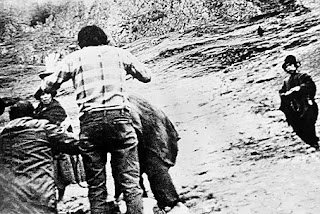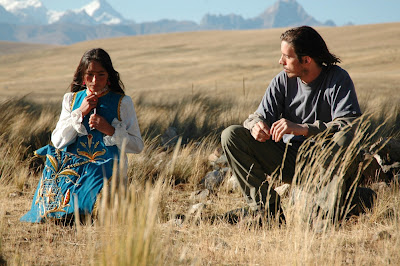 Madeinusa is one of the most successful and acclaimed Peruvian films ever: it was the country's Oscar submission last year and has won awards in film festivals in Colombia, Argentina, Havana, Hamburg, Rotterdam, as well as nominations or official selections at Sundance, Miami, Helsinki, among other places. It is also one of the most controversial films, especially within Peru itself.
Madeinusa is one of the most successful and acclaimed Peruvian films ever: it was the country's Oscar submission last year and has won awards in film festivals in Colombia, Argentina, Havana, Hamburg, Rotterdam, as well as nominations or official selections at Sundance, Miami, Helsinki, among other places. It is also one of the most controversial films, especially within Peru itself.The movie's success abroad and its fierce critique at home are not unrelated. For the source of the discomfort that it provokes is in part the notion that it provides exactly the image that outsiders have always wanted to purvey of life in the Andes. In the words of Peruvian cultural critic Victor Vich, it presents "on the whole, the usual thing: a very questionable and at times banal Orientalist exoticization, a sort of Death in the Andes with a tint of world music." Or in the somewhat less temperate version provided by one Pilar Roca, the film is "a cinematic insult": if cinema provides a country with its "face," then Madeinusa portrays to the world a country populated by "ignorant, uncouth, and savage Indians [who are] so captivated by the outside world that they have named a simple smalltown girl 'Madeinusa.'" Moreover, the film-makers were "as brutal and short-sighted as these highlanders who appear on screen raping their children, getting drunk until they fall down, and betraying the candor of an upper class young man from Lima who had dared to bring his beautiful humanity to this Hell on earth."
In short, as Fernando Vivas is quoted as saying, in an implicit nod to a controversy the previous year over inflight movies, "Madeinusa is not a movie to be shown on a plane en route to Peru."
But in fact, what better to show to incoming international visitors than the very image they seek: colorful rituals that leaven exotic if savage practices in the highlands? The film's success on the festival circuit can hardly have hindered the efforts of PromPerú, whose own website trades largely on traditional costumes and pre-Columbian ceremonies, to attract the tourist dollar. No, the debate around Madeinusa has much more to do with the country's historic internal tensions than with some Machiavellian distinction between a poor, misrepresented Latin American nation faced with an Orientalist West.
 Other critics' references to Uchuraccay and the Peruvian peace commission are more telling. Madeinusa is in this sense made more in Peru than in the USA, and the controversy has its roots in the historic divide between the coast (above all Lima) and the highlands, and in the still unhealed scars of the Sendero uprising and subsequent civil war of the 1980s and 1990s.
Other critics' references to Uchuraccay and the Peruvian peace commission are more telling. Madeinusa is in this sense made more in Peru than in the USA, and the controversy has its roots in the historic divide between the coast (above all Lima) and the highlands, and in the still unhealed scars of the Sendero uprising and subsequent civil war of the 1980s and 1990s. In this reading, the central character is less the eponymous Madeinusa, and more the metropolitan visitor, Salvador, who wanders into the highland community of Manayaycuna unaware presumably that the (fictional) village's name means "the town no-one can enter" in Quechua.
Salvador finds himself in the middle of an annual festival in which, over the Easter weekend, villagers celebrate a tiempo santo or "holy time" in which God is dead, his figure taken down from the cross and blindfolded, and so the law is suspended and there is no sin. Protagonist Madeinusa's father, the village mayor, had presumed that this year's holy time would provide the opportunity to deflower his young daughter. But it is Salvador who catches the young woman's eye, and she proffers herself to him while still in her elaborate costume of festival virgin. In turn, Salvador gradually comes to sympathize with Madeinusa's fate, terrorized as she is by her drunken, mean-spirited father and shrewish sister, Chale, alike, and eventually he agrees to take her away to Lima, to which her mother had escaped some time previously leaving only a pair of beaded ear-rings as keepsake. But when, as holy time is about to run out, Madeinusa realizes that her father has destroyed the ear-rings, she determines to poison him with soup laced with rat poison. Here, however, comes the most savage twist: discovering the murder, Chale turns on the "gringo," and so in turn does Madeinusa herself. So the putative savior becomes scapegoat, his fate (we assume) to be lynched by the vigorously xenophobic highland community.
So although the story's cinematic precursors include such films as The Wicker Man or (as strictly film school perceptively observes) Lucrecia Martel's La niña santa, in Peru itself the resonance is immediately with the fate of the eight journalists murdered by the inhabitants of the small village of Uchuraccay in 1983, early on during the Sendero civil war. And indeed Vich's comparison between this film and Mario Vargas Llosa's Death in the Andes implies this comparison, too. For Vargas Llosa was one of the celebrated authors of the report on the Uchuraccay massacre, concluding that blame had squarely to be placed on the continuing presence of premodern indigenous barbarism.
But the problem that the movie poses can be best understood in terms of subalternity and (the failures of) hegemony. Gonzalo Portocarrero suggests as much when he argues that Madeinusa portrays "Peru's impossibility": "the film depicts a country that is unviable thanks to barbarism and lack of authority amid popular culture." Naturally enough he swiftly adds: "I would like to believe that the film is wrong." But what the movie both displays and enacts is a betrayal of precisely such well-intentioned efforts on the part of the coastal elite to hegemonize the subaltern interior. That elite is shocked at the movie's refusal to endorse a politics of solidarity; but they miss the power precisely of its critique of the savior complex and power relations that underlie even (especially) the most liberal of efforts to construct the Peruvian nation.

For Madeinusa turns around the systematic destitution of authority: religious, lay, and liberal, each of which is represented in turn by the three male figures who die as the plot unfolds. Christ, the mayor, and the "gringo" all have to be killed if Madeinusa has any hope of liberation. And each is necessarily undone by treason, rather than by frontal assault or counter-hegemonic persuasion.
It's striking how much of the criticism that this film has provoked has consisted in moralizing scandal over what Ciberayllu terms the "moral transgressions" that it represents, above all the incest between father and daughter. But of course, within the logic of the film, there are no such transgressions: during holy time God is dead and the law is suspended. It is as though the outraged defenders of Peru's image could not bear this destitution of the religious authority that has, since the Spanish conquest, been one of the pillars of colonial and postcolonial subjugation.
The murder of the father and mayor has led to less comment. It's surely strange that the fearless supporters of Andean society and its representation should be least concerned of all over the fate of the only indigenous person who dies. No doubt they are carried away with the notion that to save the highlands, the "bad" indigenous will inevitably have to be purged. But this acceptance of the extrajudicial removal of corrupt indigenous leadership is, for better or for worse, hardly far removed from the practices of Sendero from which Lima's liberal left are otherwise so quick to disassociate themselves.
No, the real crime of Madeinusa is the breach it opens (the "abyss" according to Portocarrero) between the young man from Lima and the young woman from Manayaycuna. For so much of the film, after all, the plot holds out the promise of a prototypical "foundational fiction" in which romance would quasi-naturally secure the idea of nation. It is when subaltern betrayal refuses this affective mechanism of would-be hegemony that the critics sound the alarm. But why should Madeinusa exchange colonial authority or postcolonial abuse for this unfeasible tie with some liberal hegemon? She has no need of any savior in order to make her way to Lima and who knows where thereafter.

YouTube Link: the film's trailer.
No comments:
Post a Comment